|
|
 |  |  |
 |
В категории материалов: 153
Показано материалов: 41-50 |
Страницы: « 1 2 3 4 5 6 7 ... 15 16 » |
Сортировать по:
Дате ·
Названию ·
Рейтингу ·
Комментариям ·
Просмотрам
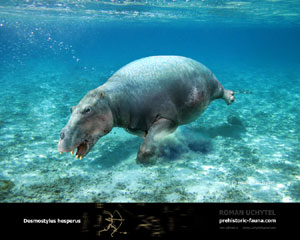 Desmostylus hesperus – extinct mammals that lived on the coast of the
North Pacific in the mid-Miocene period (15,8-12 million years ago). Their
teeth look like a bunch of columns, which reflects the name of the
animal. In Greek «desmosomes» - is a bunch, bundle, and «stilyus» - a
pillar, column. Desmostyluses have well developed fore and hind limbs
and adapted for rowing hands and feet (previously it was thought that
these animals were flippers). In water they are mainly rowing front
feet, as polar bears. Long shovel-shapped jaw animals are likely to
intensively used for plowing the sediment in search of benthic organisms
– the shells of mollusks, crabs and echinoderms. Desmostyluses reached 3
m in length, weighed 1200 kg. They were coastal lifestyle, good
swimming and diving, resting on the coastal rocks. During the breeding
season they were on the beach, though moved by land rather clumsily. The
length of the skull of the largest species, for example, Desmostylus hesperus, reaches 90 cm. Initially
Desmostyluses considered forward-relatives, but later failed to prove
their proximity to primitive Proboscidea and sirens. For the first
time the sirens and Desmostyluses combined into the one order. The
similarity with the elephants is noticeable in the presence of increased
upper and lower incisors, but also raised fangs (as opposed to
Proboscidea). Remains of Desmostyluses were found in California, Japan, Kamchatka and Sakhalin. The original image size ( 300 dpi:) A-4+ (A-3) - 500$ A-5 - 250$ A-6 - 150$
My Prints
Bestiary |
Просмотров: 1102 |
Author: roman uchytel |
Добавил: rom-diz |
Дата: 11.01.2012
|
|
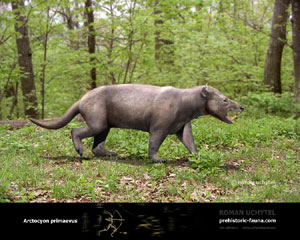 Arctocyon primaevus – from Late Paleocene-Early Eocene of North America had medium and large sizes and most probably lead a wild lifestyle. Arctocyon primaevus – from Late Paleocene-Early Eocene of North America had medium and large sizes and most probably lead a wild lifestyle.
In
the Early Paleogene niche of large carnivores mostly was empty, and at
different times specimens from different groups of archaic mammals have
made more or less successful attempts to fill them. Arctocyonidaes
are one of such attempts. Cheek teeth of these ancient ungulates had
flattened crowns, which suggests for them rather than meat the
omnivorous diet.
However,
in many ways it can be assumed that over time some Arctocyonidaes
increasingly began to include in their diet vegetarian food, in parallel
increasing in sizes. The second half of Paleocene Arctocyonidaes, for
example, have already reached the size of wolves or even small bears.
The original image size ( 300 dpi:) A-4+ (A-3) - 300$ A-5 - 150$ A-6 - 100$
My Prints
Bestiary |
Просмотров: 2138 |
Author: roman uchytel |
Добавил: rom-diz |
Дата: 11.01.2012
|
|
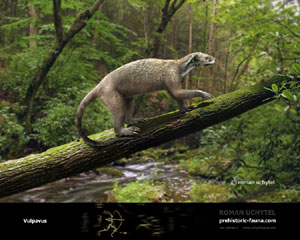 Vulpavus (Miacines) –
ancient primitive carnivores that lived in the Paleocene and Eocene and
became extinct 34 million years ago. Probably, they were the ancestors
of all contemporary carnivores. Different species were living on the
trees or on the ground. Miacines divided into two groups: Miacines (with the full molars) and Viverravines (with a reduced number of molars and more specialized carnivorous teeth). Vulpavus (Miacines) –
ancient primitive carnivores that lived in the Paleocene and Eocene and
became extinct 34 million years ago. Probably, they were the ancestors
of all contemporary carnivores. Different species were living on the
trees or on the ground. Miacines divided into two groups: Miacines (with the full molars) and Viverravines (with a reduced number of molars and more specialized carnivorous teeth).
Vulpavus
– the representative of Miacines – was rather primitive predator and
looks like tayra with a small body and long tail. He ate everything he
could catch – birds, insects and small mammals.
The original image size (300 dpi:) A-4+ (A-3) - 200$ A-5 - 140$ A-6 - 100$
My Prints
Bestiary |
Просмотров: 1261 |
Author: roman uchytel |
Добавил: rom-diz |
Дата: 11.01.2012
|
|
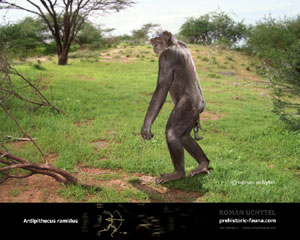 Ardipithecus ramidus – an ancient hominid genus, known from the Early Pliocene (about 5,8 – 4,4 million years ago). Since the genus Ardipithecuses have
many similarities with Africana apes, some authors considered them more
likely ancestors of chimpanzees than humans. However, most consider
them the oldest human ancestors because of the similarity of the teeth
with the teeth of Australopithecus. In addition, there is additional
small calf-bone in Ardipithecus’s foot (os peroneum),
which is present in the human foot, but is absent in the feet
contemporary apes. Sometimes Ardipithecuses belong to early
Australopithecus because their skull is somewhere between both of them.
Judging by the size of bones, Ardipithecuses in their size were
comparable to those of chimpanzees. Ardipithecus ramidus – an ancient hominid genus, known from the Early Pliocene (about 5,8 – 4,4 million years ago). Since the genus Ardipithecuses have
many similarities with Africana apes, some authors considered them more
likely ancestors of chimpanzees than humans. However, most consider
them the oldest human ancestors because of the similarity of the teeth
with the teeth of Australopithecus. In addition, there is additional
small calf-bone in Ardipithecus’s foot (os peroneum),
which is present in the human foot, but is absent in the feet
contemporary apes. Sometimes Ardipithecuses belong to early
Australopithecus because their skull is somewhere between both of them.
Judging by the size of bones, Ardipithecuses in their size were
comparable to those of chimpanzees. Ardipithecuses lived in tropical forests and woodlands, they have been able to upright posture, but were able to climb trees. Ardipithecuses ate fruits and nuts.
Fragments of the Ardipithecus
ramidus skeleton were first discover in the 1990s. Their age was
determined from above and below the overlying volcanic rocks as 4,4
million years ago. An individual-possessor skeleton trove researches
named «Ardy», which in Afar language means «land».
The original image size (300 dpi:) A-4+ (A-3) - 250$ A-5 - 150$ A-6 - 100$
My Prints
Bestiary |
Просмотров: 1175 |
Author: roman uchytel |
Добавил: rom-diz |
Дата: 11.01.2012
|
|
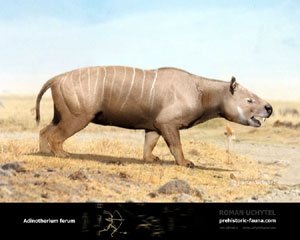 Adinotherium - an extinct mammal of the Toxodontidae family, a representative of the South American fauna of Miocene age. In general, he resembled a scaled-down version of his relative Toxodon. Adinotherium’s
forefeet were higher than Toxodon, so the height at the shoulders and
the pelvis were equal, which facilitated the running. There are several
types of Adinotherium: Adinotherium ferum and Adinotherium ovinum. The largest of them - Adinotherium ovinum, reaching 1.5 meters in length, with an increase of about 80cm and weighing 120 kg. The original image size ( 300 dpi:) A-4+ (A-3) - 300$ A-5 - 150$ A-6 - 100$
My Prints
Bestiary |
Просмотров: 1253 |
Author: roman uchytel |
Добавил: rom-diz |
Дата: 11.01.2012
|
|
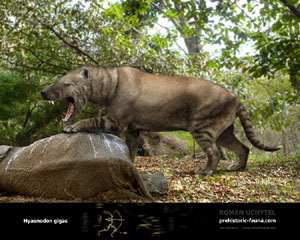 Hyaenodons - creodontas genus of the gienodontal family
(Hyaenodontidae) from the middle Eocene - early Miocene of Europe, Asia
and North America. Members of the genus differ considerably in size
and occupied various niches of terrestrial predators. The earliest known
Hyaenodons found in Asia and the date middle-eocene age. During the
second half of the Eocene epoch Hyaenodons settled across the northern
hemisphere, often occupying released endangered oxyenides (Oxyaenidae)
ecological niche. They have become quite commonplace in much of Asia,
North America and Europe, but Africa somehow passed. It may seem that
outwardly resembled Hyaenodons several modern members of the canine
family, in fact, they were far from their peers. This race is much more
united in a variety of animals, who have held a variety of niches
predators of the land. The largest of the genus, for example,
Hyaenodon gigas, didn’t yield in their sizes the largest tiger's: the
head, according to the size of their teeth and jaw fragments, reached 50
cm or more. Support a heavy head is rather short and very strong neck.
Powerful neck was also need to keep their teeth and caught escaping
prey. Judging by the structure of the cervical spine, Hyaenodons have
been set high head, so their neck is positioned almost vertically. They
grabbing their prey, like the modern dogs, a toothy mouth (not like a
cat - with claws and teeth). The larger members of the genus are
relatively long and slender limbs, based on several parties divorced in
the fingers, and apparently adapted to the active movement on hard
ground. With moving the hind limbs Hyaenodons could make sharp throws
for prey, and the front may have been needed to cope with food until it
got to fall. It is very likely that these predators were digging with
its front paws the ground, looking for small animals, that live in
burrows, or holes arranged themselves. With a rather massive
addition, gienodons, probably, wouldn’t have been able to a long
running.They were likely ambush predators, briefly, but actively
pursuing prey - approximately the same goes most of today's large and
small cats. There is no doubt that Hyaenodon was able to catch, throw and to cut a relatively large animal. The original image size ( 300 dpi:) A-4+ (A-3) - 250$ A-5 - 150$ A-6 - 100$
My Prints
Bestiary |
Просмотров: 1832 |
Author: roman uchytel |
Добавил: rom-diz |
Дата: 11.01.2012
|
|
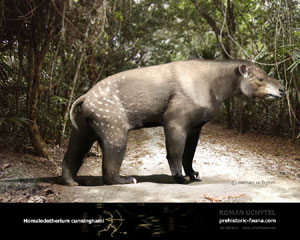 Homalodotherium cunninghami - one of the most striking
representatives of the South American fauna Eocene epoch. Reached 2.5 m
in length, taking into account the growth of the tail and up to 120 cm,
and weighs about 300 kg. The skull was quite impressive - up to 41 cm in
length. As members of the order Notoungulata, the so-called southern ungulates, they surprisingly looked like Chalicotherium, who are members of the order perissodactyls (Perissodactyla) and are not to Homalotheriidae in close relatives. In
the Miocene South American continent was not connected to North America
by the Isthmus of Panama, and the local fauna, while in isolation,
evolved differently. Superficial resemblance of Homalodotherium to
Chalicotherium dictated by a similar ecological niche, which is occupied
by both not related to each other animals groups, and is the result of
convergent evolution. The original image size ( 300 dpi:) A-4+ (A-3) - 300$ A-5 - 150$ A-6 - 100$
My Prints
Bestiary |
Просмотров: 1088 |
Author: roman uchytel |
Добавил: rom-diz |
Дата: 11.01.2012
|
|
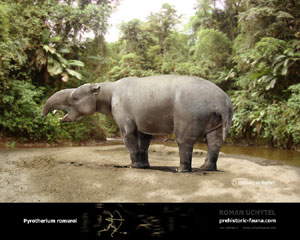 Pyrotherium - extinct South American mammals of the superorder
hoofed animals that lived in the Eocene and Oligocene. Pyrotherium have
convergent similarity with the primitive Proboscidea, which was caused
by the similarity of their ecological niches occupied. Pyrotherium
differed massive physique, columnar legs with short and wide toes, as
well as a large head with a small trunk. The four upper and two lower
incisor teeth, resembling tusks, were issued in advance. These animals
reach 3 m in length and 1.5 m tall at the shoulders. The name, which
in Greek means «the fiery beast», was given because of the fact that the
first fossils of Pyrotherium were found in sedimentary rocks of
volcanic ash. In comparison with other orders of the South American
ungulates, Pyrotheriums were relatively not varied order. Period of
their existence is also not particularly long. Pyrotherium kinship with
other South American ungulates (Meridiungulata) is currently not clear.
The structure of the tarsus does not indicate any obvious relationship
with them. Most Pyrotherium’s tarsus is similar to Arsinoitherium’s
tarsus, but it is unclear about evidence of relationship of these
animals (who are representatives of different orders), or this
similarity is dictated by a similar method of movement (it means -
convergence). The original image size ( 300 dpi:) A-4+ (A-3) - 300$ A-5 - 150$ A-6 - 100$
My Prints
Bestiary |
Просмотров: 1007 |
Author: roman uchytel |
Добавил: rom-diz |
Дата: 11.01.2012
|
|
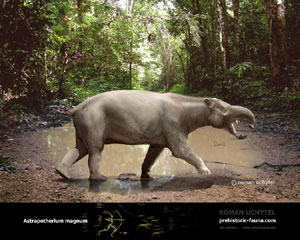 Astrapotherium magnum – the genus of large ungulates from the late Oligocene - middle Miocene of South America. They are the most well-studied members of Astrapotherias order. Astrapotherium magnum – the genus of large ungulates from the late Oligocene - middle Miocene of South America. They are the most well-studied members of Astrapotherias order.
They represented a fairly large animals - the length of their bodies reached 288 cm, height was 137 cm and weight is likely as high as 600-800 kg. Their heads was large enough relative to the body; skull length - 65 cm.
For
Astrapotheriums is marked sexual dimorphism which is expressed first of
all in the difference in sizes, shape and configuration of the canines
of males and females. Males have lower canines relatively longer,
thicker and forward. Females have shorter, thinner and relatively longer
bend outward canines. These unusual ungulates was probably strongly
attached by water habitats, however, not excluded the possibility of
living in the humid lowland forests. They had a strong elongated body,
and their hind legs, given the massiveness of these animals, were
relatively weak. A small but powerful five-fingered foot was suitable
for walking on swampy, soft ground. According to some researchers, this
may indicate that Astrapotheriums spent much time in the water because
on the land the creatures with such a disproportionate constitution
almost certainly would have been quite awkward. Their canines were like
the tusks and could be used to remove the bark, branches and pulling out
grabbing roots. At the same time, the branch of the plant, that grew
along the banks, could bend down and attracted to his mouth with a trunk
and tusks. The reasons of extinction of genus as the other members of
the order, remain unknown. Most likely they were associated with changes
in the environment, destroyed the usual habitat of these ecologically
sensitive animals. Is not excluded also competition from the other South
American ungulates.
The original image size ( 300 dpi:) A-4+ (A-3) - 300$ A-5 - 150$ A-6 - 100$
My Prints
Bestiary |
Просмотров: 1320 |
Author: roman uchytel |
Добавил: rom-diz |
Дата: 11.01.2012
|
|
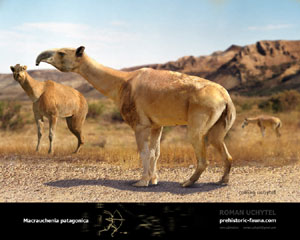 Macrauchenia patagonica – representatives of the order litopterna,
which belonged to a very specific South American ungulates. Most of the
representatives litoptern extinct at the end of the Pliocene, after an
overland to North America, the emergence of new predators and
competition from new prey. Macrauchenias were quite attuned to adapt to
survive until the end of the Pleistocene. Macrauchenia patachonica died,
apparently, only 10 thousand years ago. This ungulate reached 1,8 m
height at the shoulders, which corresponds to the modern camel, and
weighed a ton. Long and very strong legs ended with three fingers. The
neck was very long, and the front segment is probably end with
proboscis, adapted for plucking leaves, although the structure of teeth
more like a grass eaters. The remains of Macrauchenias were found, first
of all, in the southeastern Pampas, but the findings are also known in
Venezuela.
The original image size ( 300 dpi:) A-4+ (A-3) - 300$ A-5 - 150$ A-6 - 100$
My Prints
Bestiary |
Просмотров: 1107 |
Author: roman uchytel |
Добавил: rom-diz |
Дата: 11.01.2012
|
|
|  |
 |  |  |
|
 |
| Кто здесь? |
 | Онлайн всего: 1 Гостей: 1 Пользователей: 0
|  |
 |
|
|

